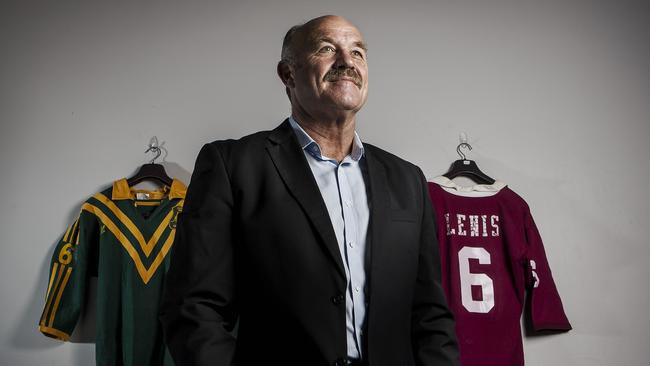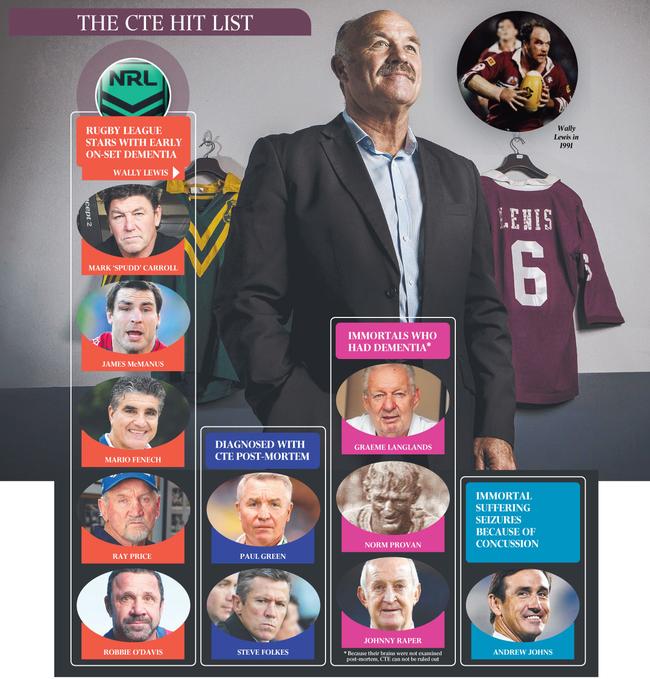Footballers’ dementia list skyrockets
Rugby league immortal Wally Lewis is the latest star on growing list of star footballers battling early on-set dementia because of head knocks.

Leading sports neurologist Rowena Mobbs has revealed she is treating more than 40 rugby league players for brain injuries, as Queensland great Wally Lewis becomes the fourth of just 13 Immortals to be diagnosed with dementia.
Pressure is growing on the NRL to deal with the CTE crisis enveloping the game after the Queensland Origin great revealed his diagnosis of early onset dementia, which has been linked to his decorated football career.
Chronic traumatic encephalopathy is a specific type of dementia caused by repetitive head knocks. It’s not known how many former players will develop the disease, but early in July a Victorian coronial inquest heard up to 17 per cent of former collision sport athletes were at risk of developing CTE.
A Senate inquiry into concussion and repeated head injury is due to hand down findings on Wednesday, and may make recommendations to reduce the amount of exposure players have to head injury, including reducing contact training sessions.
Lewis, 63, played more than 370 games and joins other stars including Mark Carroll, James McManus, Mario Fenech, Ray Price and Robbie O’Davis who have also been diagnosed with early on-set dementia by Dr Mobbs.
Three other Immortals – a title bestowed to the greatest to have played the game – Graeme Langlands, Norm Provan and Johnny Raper, all died with dementia. But because their brains were not examined post mortem, CTE cannot be ruled out.
Traumatic brain injury increases the risk of all dementias, not just CTE. This includes Alzheimer’s disease, ALS, motor neurone disease and Parkinson’s disease.
Cowboys coach and former league star Paul Green and Bulldogs great Steve Folkes were diagnosed with CTE at post mortem by the Australian Sports Brain Bank.
Dr Mobbs, who says she diagnoses elite and non-elite footballers with brain-related conditions weekly, knows of three top-tier rugby league teams with high rates of dementia.
“I have now heard from the community that three top football teams from the 1970s to the 1990s are in trouble for high rates of dementia. Each patient and family I see seems to know someone else in trouble,” Dr Mobbs said.

“This will remain anecdotal until we gather funding for epidemiological studies into CTE in Australia.
Dr Mobbs says she has seen more than 100 “in trouble” and has another 100 under watch after being involved in contact sports, boxing and other circumstances such as military blast injury.
She said more than 40 elite and amateur league footballers made up about one-third of her list.
“As one neurologist alone, I have seen over 100 in trouble, another 100 patients under watch, mainly through playing footy for 20-30 years,” Dr Mobbs said. “If we extrapolate to those in the community with over 10 years of footy at higher levels, then even a small percentage affected could mean tens of thousands of Australians with CTE.
“I say this with compassion, not alarmism, and an optimism that the codes will choose to act strongly on CTE. They have concussion policies, but concussion risk alone doesn’t cut into the subconcussion risk of training contact and age of contact commencement in these sports. It is a tragedy to see our heroes like Wally Lewis affected but an even greater tragedy that the codes can’t seem to name and target CTE.”
Carroll has implored the code to do more, saying his phone rings constantly with former teammates and foes battling memory loss, mood outbursts and searching for help.
“I told you there were loads more, hopefully with myself and the great king of rugby league, Wally Lewis telling our stories, it will encourage more people to get help and see Dr Rowena Mobbs,” Carroll said.
Carroll said he and former Bulldogs and St George player James Graham would meet NRL chiefs Andrew Abdo and Peter V’landys about the issue and the care needed for footballers after retirement.
The wives and partners of former footballers are also demanding more support from the game.
Lynn McGregor who’s husband Rod McGregor, 66, a member of the Red V’s 1977 premiership team, has said daily life with him is “like living with a five-year-old”.
She appealed to Mr V’landys and Mr Abdo to do more to support the wives of former footballers who she said had been forgotten.
“It’s everywhere, it is an epidemic,” Ms McGregor said of the issue. “There would be thousands. The thing is thousands of women suffer alongside them.
“It’s dealing with mood outbursts … the loneliness you have living with someone. Socially isolating. Everybody disappears … I am tired.”
“I would just like the NRL to acknowledge these guys exist. My husband played for 20 years. I am not about blaming, I am about just getting this acknowledgment.”




To join the conversation, please log in. Don't have an account? Register
Join the conversation, you are commenting as Logout